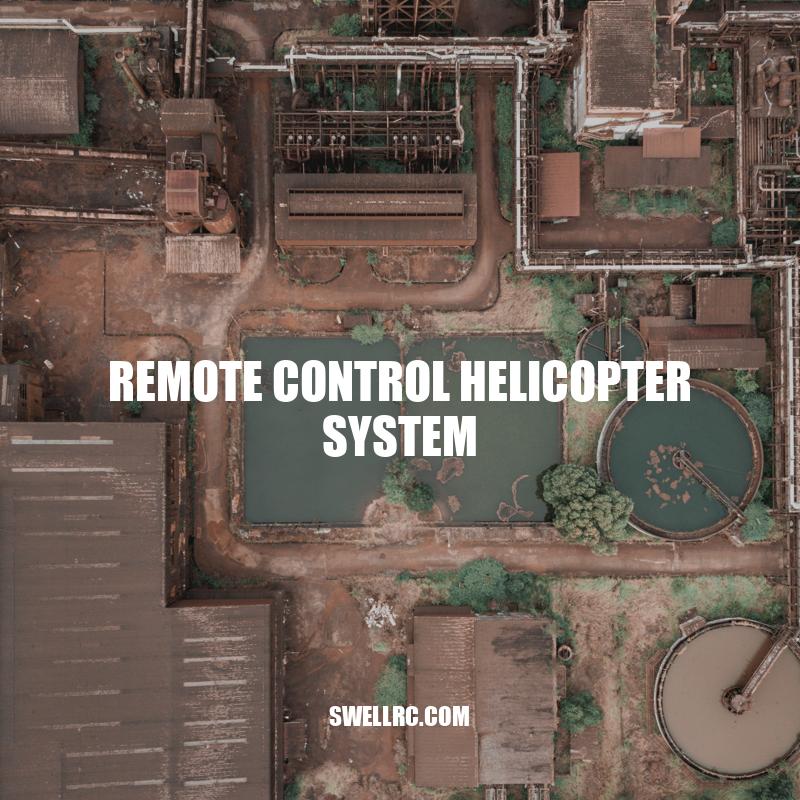Remote Control Helicopter Systems: A Comprehensive Guide
Remote control helicopter systems have become increasingly popular in recent years, attracting hobbyists and enthusiasts from all walks of life. These systems offer a fun and versatile way to enjoy flying and maneuvering a miniature aircraft. With advances in technology, remote control helicopter systems have become more affordable and user-friendly, making them accessible to a broader audience. Remote control helicopter systems come in a variety of types, each with its unique features and benefits. While gas-powered helicopters are known for their power and speed, electric models are quieter and easier to maintain. Nitro-powered helicopters offer an experience that’s closest to flying a real helicopter. Regardless of the type chosen, all remote control helicopter systems share a similar set of components that enable them to function. These components include the transmitter, the receiver, the rotor blades, the gyroscope, and the servos. In this article, we’ll take a closer look at the different types of remote control helicopter systems, their components, how to fly them, maintenance and repair, and advancements in the field.
Types of Remote Control Helicopter Systems
There are many different types of remote control helicopter systems, each with its own unique features and benefits. Here are four common types:
- Gas-Powered Remote Control Helicopters: These helicopters are powered by gasoline engines. They offer high power and speed but are also noisy and require significant maintenance. Some popular gas-powered remote control helicopter brands include Align, Gaui, and Hirobo.
- Electric Remote Control Helicopters: These helicopters are powered by batteries and are known for their quiet operation and low maintenance. They are ideal for beginners and casual hobbyists. Popular brands of electric remote control helicopters include Blade, E-flite, and Syma.
- Nitro-Powered Remote Control Helicopters: These helicopters are powered by nitro fuel and offer an experience that is closest to flying a real helicopter. Nitro-powered remote control helicopters are known for their sound and smell but require significant maintenance. Popular brands of nitro remote control helicopters include Thunder Tiger, HPI, and JR Helicopters.
- Toy Remote Control Helicopters: These helicopters are designed for kids and beginners to enjoy without investing too much in a hobby-grade helicopter. They are generally small, lightweight, and can fly only indoors. These may not include essential components like a gyro which makes it harder to keep them aloft. Some popular toy helicopter brands include Air Hogs, Syma, and Silverlit.
When choosing a remote control helicopter system, it is essential to consider factors like experience, budget, and preferences. Online marketplaces like Amazon, Horizon Hobby, and Motion RC can offer a wide range of remote control helicopter products, from complete starter kits to replacement parts.
What are remote control helicopters called?
Remote control helicopters are commonly known as RC helicopters or simply, model helicopters. They are controlled using a remote or transmitter that sends signals to the helicopter via radio waves. There are a variety of RC helicopters available in the market, ranging from beginner-level models to advanced ones. Some popular types include:
- Coaxial helicopters
- Single blade helicopters
- Quadcopters
If you are interested in purchasing an RC helicopter, there are many websites that offer a wide range of options. Some popular websites include Amazon, HobbyKing, and Horizon Hobby. Additionally, it’s important to consider factors such as flight time, battery life, and durability when choosing an RC helicopter.
Components of a Remote Control Helicopter System
A remote control helicopter system consists of several components that work together to control and maneuver the aircraft. Here are some essential components:
- Transmitter: The user holds the transmitter and controls the helicopter’s movements using joysticks. The transmitter sends signals to the receiver through a radio or infrared (IR) signal.
- Receiver: The receiver is on board the helicopter and receives signals from the transmitter. It then sends the signals to the appropriate servo to move individual controls.
- Main and Tail Rotor Blades: The main rotor blades provide lift and direction, while the tail rotor blades provide stability and directional control.
- Gyroscope: The gyroscope detects the helicopter’s movement and helps maintain its balance and stability. Some advanced helicopters have several gyroscopes to increase stability.
- Servos: Servos are small motors that control the movement of the helicopter’s rotor blades and respond to the signals sent by the transmitter.
Remote Control Helicopter Parts Diagram
| Main Rotor Blades | Gyroscope | Receiver |
|---|---|---|
 |
 |
 |
| Tail Rotor Blades | Transmitter | Servos |
 |
 |
 |
It is essential to have all the components in good condition to ensure safe and efficient flight. Regular maintenance and checking for wear and tear on parts like the rotor blades and servos help reduce the risk of accidents. Some online resources like RC Groups, Remote Control Helicopter Forum, and HeliFreak offer forums and discussions among hobbyists and enthusiasts to share knowledge, tips and troubleshoot common problems.
What are the components of remote control helicopter?
A remote control helicopter is composed of several components that work together to make it fly and maneuverable, such as:
| Component | Description |
|---|---|
| Frame | The structure of the helicopter that holds all the components together |
| Motor | The engine that powers the rotors and propels the helicopter forward |
| Rotors | The rotating blades that lift the helicopter up and control its movement |
| Battery | Provides power to the motor and the electronics on board |
| Receiver | Receives and interprets the signals from the remote control, giving instructions to the helicopter |
| Transmitter | The handheld device that sends commands to the helicopter via radio signals |
| Gyro | A device that helps stabilize the helicopter during flight |
There are many different types of remote control helicopters available on the market, ranging from small indoor models to larger outdoor ones. The components may vary somewhat depending on the specific model. If you’re interested in purchasing a remote control helicopter, there are plenty of websites and online stores that offer a wide selection, such as Amazon.com and Hobbytron.com.
Flying a remote control helicopter system can be easy and fun with practice. Here are some basic steps:
- Set up: Find a safe and open space without obstacles like trees or power lines. Connect the battery and turn on the transmitter and receiver.
- Take Off and Landing: Slowly increase the throttle to lift off the ground and take the helicopter to hovering altitude. Carefully land the helicopter by decreasing the throttle.
- Altitude: Control the altitude of the helicopter with the throttle. Rolling the throttle forward increases altitude, rolling it backward decreases altitude.
- Control Movement: Use the joystick on the transmitter to control the helicopter’s movement by tilting it forward/backward or left/right.
- Adjust Angle: Adjust the helicopter’s angle with the cyclic control and rudder pedal.
It is essential to remember that flying a remote control helicopter system takes practice and patience. Beginners may crash the helicopter several times before mastering the skill. Safety is also crucial in handling a remote control helicopter system. Wearing protective gear like goggles or gloves and avoiding flying near people or pets can prevent harm.
Some online resources offer helpful articles and tutorials that provide additional guidance for beginner and advanced users. Websites like My Cool Heli and RC Helicopter Fun offer articles, product reviews, and tutorials for enthusiasts. Products like Blade 230s V2 RTF, Hubsan X4 H107C, and Syma S107G are popular among beginners and can be purchased on popular e-commerce sites like Amazon or Best Buy.
How hard is it to fly a remote control helicopter?
Flying a remote control helicopter can be quite challenging, especially for beginners. You’ll need to master a few basic skills to control the helicopter’s movements effectively, such as takeoff, hovering, flying forward and backward, turning left and right, landing, and more. The difficulty level may vary depending on the helicopter’s size, speed, and maneuverability. It’s best to start with a basic, easy-to-control model and progress to more advanced models as you develop your skills.
There are plenty of online resources available to help you learn how to fly a remote control helicopter. A quick search on YouTube will yield plenty of instructional videos to get you started. You can also check out forums and blogs dedicated to RC helicopters for tips and tricks from experienced hobbyists.
Additionally, some manufacturers offer beginner-friendly models designed specifically for those who are new to the hobby. For example, Syma offers a range of affordable, easy-to-control helicopters, such as the popular Syma S107G, which is known for its stability and durability.
In summary, flying a remote control helicopter isn’t the easiest hobby to master, but with practice and patience, anyone can learn to do it well.
Maintenance and Repair of a Remote Control Helicopter System
Maintaining and repairing a remote control helicopter system is essential to keep it in good condition. Here are some tips for proper maintenance and repair:
- Cleaning: Clean the helicopter after each use with a soft, damp cloth. Avoid using water or cleaning solvents to prevent damage.
- Storage: Store the helicopter in a cool and dry place. Disconnect the battery and remove it from the helicopter to prevent damage from overcharging or leakage.
- Check for wear and tear: Regularly check the helicopter’s parts for signs of wear and tear. Replace damaged or broken parts immediately.
- Battery care: Properly charge, discharge, and store the battery to prolong its lifespan. Avoid overcharging or undercharging the battery.
- Troubleshooting: Troubleshoot common issues such as unresponsive controls, rotor damage, or motor malfunction. Refer to the user manual or contact customer support for assistance if necessary.
There are also many resources available for tips and repair tutorials for remote control helicopters. Websites like RC Helicopter Guide and RC Helicopters 4 Beginners offer articles, videos, and forums for enthusiasts to connect and share knowledge. Online retailers like Horizon Hobby and AMain Hobbies provide replacement parts and accessories for various types of remote control helicopters.
Proper maintenance and repair can help extend the life of a remote control helicopter system and improve its performance. It is essential to follow the manufacturer’s recommendations and take safety precautions when handling the helicopter and its components.
How does a remote control helicopter work?
A remote control helicopter works by using a transmitter to send signals to the helicopter’s receiver, which then controls the various motors that make up the helicopter’s rotors. These rotors are then able to spin at different speeds and angles, allowing the helicopter to move in various directions. Some remote control helicopters also include gyroscopes and accelerometers to help stabilize the helicopter during flight.
If you’re interested in purchasing a remote control helicopter, websites such as Amazon, Best Buy, and HobbyKing offer a range of options for all skill levels. Make sure to do proper research before purchasing to ensure you get a reliable and high-quality product.
Advancements and Innovations in Remote Control Helicopter Systems
Technology has improved remote control helicopter systems, making them more advanced and versatile. Here are some of the latest advancements in remote control helicopter systems:
- Camera mounts: Integrated camera mounts allow users to attach cameras to remote control helicopters. This feature is useful for capturing aerial footage for photography or videography purposes.
- GPS tracking systems: Some remote control helicopter systems are equipped with GPS tracking systems, which help users track the location of their helicopter and ensure a safe return home.
- Obstacle avoidance technology: Obstacle avoidance technology utilizes sensors to recognize and avoid obstacles in the helicopter’s flight path, preventing mid-air collisions and accidents.
- 3D printing: With 3D printing technology, users can create and print their helicopter parts, making repairs and replacements easier and more cost-effective.
- Auto-pilot mode: Auto-pilot mode allows users to program their helicopter to fly a specific route or pattern, making it easier to capture footage or navigate difficult areas.
Manufacturers like DJI and Blade specialize in producing high-quality and innovative remote control helicopter systems that incorporate many of these advancements. These companies not only offer products but also resources and communities for enthusiasts to connect and share knowledge.
Overall, advancements in remote control helicopter systems have made flying safer, easier, and more enjoyable. With the right knowledge and tools, hobbyists can discover new possibilities and expand their skills in this exciting field.
What are the features of remote control helicopter?
Remote control helicopters have many features that make them appealing to hobbyists and enthusiasts. Here are some of the key features:
- Remote control helicopters can fly in any direction, making them highly maneuverable.
- They feature gyro stabilization, which keeps the helicopter steady in flight and helps prevent crashes.
- Many models have adjustable speed and altitude, allowing for greater customization and control.
- Remote control helicopters often have built-in cameras, allowing users to take aerial photos and videos.
- They can be powered by rechargeable batteries, making them an eco-friendly option for hobbyists.
If you’re interested in purchasing a remote control helicopter, there are many websites and products available. Some popular options include the Blade Nano CP S2, the Syma S107G, and the Holy Stone HS100D. These products offer a range of features and options for users of all skill levels.
Conclusion
Remote control helicopter systems are a thrilling and rewarding hobby that can bring hours of enjoyment. They offer creativity, relaxation, and the opportunity to connect with other enthusiasts. With advancements in technology and availability of resources, users are only limited by their imagination.
It’s important to remember that proper use and maintenance of remote control helicopter systems are crucial for longevity and safety. By following proper care and use instructions, users can avoid accidents and damages to their equipment.
If you’re considering getting into the world of remote control helicopter systems, remember to do your research and start slow. Many communities, resources, and online stores are available to assist you in your journey.
In conclusion, remote control helicopter systems are an excellent source of entertainment and education. This fun and challenging hobby can stimulate our creativity, foster our technical knowledge, and bring us closer to nature. With a bit of practice and determination, you can become an expert pilot of your very own flying machine.



